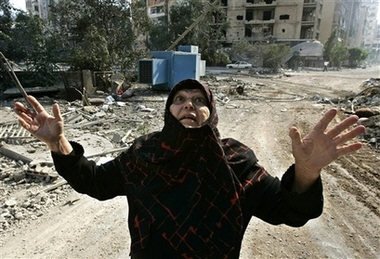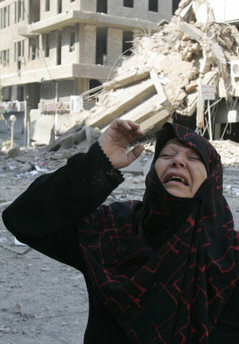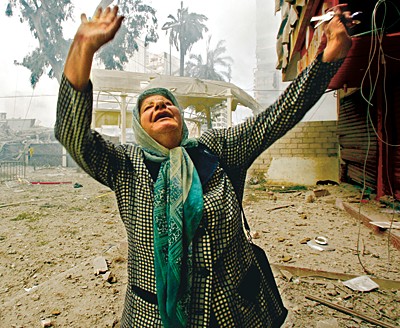William J. Mitchel is quoted as saying that digital images should be regarded as "fragments of informatin that circulate in high-speed networks ... and can be received, transformed, and recombined like DNA to produce new intellectual structures having their own dynamics and value" (p. 219). What, then, do we make of the increasingly common instances when digital images are deliberately manipulated for news distribution? The book gives an example of a doctored photograph of the president addressing a group soliders, such that president's audience appears significantly larger than it actually was. While this is a relatively innocuous example of alteration in a source of news, there have been examples of far more mendacious images making the news in the last several years.
A striking example of this phenomenon comes from photographs taken during the 2006 Israel-Lebanon conflict. The controversy involves multiple photos published by the Reuters news service depicting scenes from the conflict. The controversy began when bloggers first pointed out clear indications on the published photographs of digital manipulation, which can be seen in the image comparison below (the image on the left is altered, the image on the right is the original).

Further research showed that many of the photographs provided by freelance Lebanese photographer Adnan Hajj were in fact altered, or staged. This website provides many other examples of "candid" news photo manipulation, including mis-captioning and placed objects. It also demonstrates a series of staged scenes (released in news photographs at different times) where the same woman "finds" her home destroyed by Israeli fire on three different dates, in three different locations.



Thus, although these may indeed be fragments of information that produce "new intelletual structures having their own dynamics and value," they are nevertheless regarded in the specific context of providing what viewers assume is honest, objective information. Thus, we can see that through image alteration, individuals and organizations can go far beyond promoting a political agenda; in fact, they can fully affect the perception of reality by individuals or masses of people.
It is clear that the controversy following these pictures ("Reutersgate") was warranted. After all, how could top photographic editors miss signs of alteration that did not escape internet bloggers? But here, perhaps, we are faced with one of today's realities in reporting news, which is that extreme, sensational news sells better. Therefore, is it possible that signs of alteration were overlooked (unintentionally or purposefully) because they would "sell better" (be more exciting to the public) than reality? Was the photo editor responsible partial in some way to one of the sides in the conflict, and reluctant to critically examine a photo promoting a view he believed in? And most importantly, how easy and frequent are these sorts of alteration in more common, less politicized settings? After all, when a news story is less emotionally charged, bloggers are less likely to examine accompanying photos for signs of alteration or changes.



